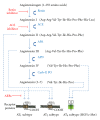Importance of the brain Angiotensin system in Parkinson's disease
- PMID: 23213621
- PMCID: PMC3503402
- DOI: 10.1155/2012/860923
Importance of the brain Angiotensin system in Parkinson's disease
Abstract
Parkinson's disease (PD) has become a major health problem affecting 1.5% of the world's population over 65 years of age. As life expectancy has increased so has the occurrence of PD. The primary direct consequence of this disease is the loss of dopaminergic (DA) neurons in the substantia nigra and striatum. As the intensity of motor dysfunction increases, the symptomatic triad of bradykinesia, tremors-at-rest, and rigidity occur. Progressive neurodegeneration may also impact non-DA neurotransmitter systems including cholinergic, noradrenergic, and serotonergic, often leading to the development of depression, sleep disturbances, dementia, and autonomic nervous system failure. L-DOPA is the most efficacious oral delivery treatment for controlling motor symptoms; however, this approach is ineffective regarding nonmotor symptoms. New treatment strategies are needed designed to provide neuroprotection and encourage neurogenesis and synaptogenesis to slow or reverse this disease process. The hepatocyte growth factor (HGF)/c-Met receptor system is a member of the growth factor family and has been shown to protect against degeneration of DA neurons in animal models. Recently, small angiotensin-based blood-brain barrier penetrant mimetics have been developed that activate this HGF/c-Met system. These compounds may offer a new and novel approach to the treatment of Parkinson's disease.
Figures

Similar articles
-
The development of small molecule angiotensin IV analogs to treat Alzheimer's and Parkinson's diseases.Prog Neurobiol. 2015 Feb;125:26-46. doi: 10.1016/j.pneurobio.2014.11.004. Epub 2014 Nov 29. Prog Neurobiol. 2015. PMID: 25455861 Review.
-
Noradrenaline neuron degeneration contributes to motor impairments and development of L-DOPA-induced dyskinesia in a rat model of Parkinson's disease.Exp Neurol. 2014 Jul;257:25-38. doi: 10.1016/j.expneurol.2014.04.011. Epub 2014 Apr 18. Exp Neurol. 2014. PMID: 24747357
-
Nicotine and Nicotinic Receptor Drugs: Potential for Parkinson's Disease and Drug-Induced Movement Disorders.Int Rev Neurobiol. 2015;124:247-71. doi: 10.1016/bs.irn.2015.07.005. Epub 2015 Aug 18. Int Rev Neurobiol. 2015. PMID: 26472532 Review.
-
Expanding the repertoire of L-DOPA's actions: A comprehensive review of its functional neurochemistry.Prog Neurobiol. 2017 Apr;151:57-100. doi: 10.1016/j.pneurobio.2016.07.002. Epub 2016 Jul 4. Prog Neurobiol. 2017. PMID: 27389773 Review.
-
Post mortem studies in Parkinson's disease--is it possible to detect brain areas for specific symptoms?J Neural Transm Suppl. 1999;56:1-29. doi: 10.1007/978-3-7091-6360-3_1. J Neural Transm Suppl. 1999. PMID: 10370901 Review.
Cited by
-
A Role for the Brain RAS in Alzheimer's and Parkinson's Diseases.Front Endocrinol (Lausanne). 2013 Oct 25;4:158. doi: 10.3389/fendo.2013.00158. Front Endocrinol (Lausanne). 2013. PMID: 24298267 Free PMC article. Review.
-
Convergent evidences from human and animal studies implicate angiotensin I-converting enzyme activity in cognitive performance in schizophrenia.Transl Psychiatry. 2015 Dec 8;5(12):e691. doi: 10.1038/tp.2015.181. Transl Psychiatry. 2015. PMID: 26645626 Free PMC article.
-
Recent Advances in the Endogenous Brain Renin-Angiotensin System and Drugs Acting on It.J Renin Angiotensin Aldosterone Syst. 2021 Nov 30;2021:9293553. doi: 10.1155/2021/9293553. eCollection 2021. J Renin Angiotensin Aldosterone Syst. 2021. PMID: 34925551 Free PMC article. Review.
-
Angiotensin II (de)sensitization: Fluid intake studies with implications for cardiovascular control.Physiol Behav. 2016 Aug 1;162:141-6. doi: 10.1016/j.physbeh.2016.01.020. Epub 2016 Jan 19. Physiol Behav. 2016. PMID: 26801390 Free PMC article. Review.
-
Side chain similarity comparisons for integrated drug repositioning and potential toxicity assessments in epidemic response scenarios: The case for COVID-19.Comput Struct Biotechnol J. 2020;18:2931-2944. doi: 10.1016/j.csbj.2020.10.013. Epub 2020 Oct 21. Comput Struct Biotechnol J. 2020. PMID: 33101604 Free PMC article.
References
-
- Olanow CW, Stern MB, Sethi K. The scientific and clinical basis for the treatment of Parkinson disease. Neurology. 2009;72(21, supplement 4):S1–S136. - PubMed
-
- Ehringer H, Hornykiewicz O. Distribution of noradrenaline and dopamine (3-hydroxytyramine) in the human brain and their behavior in diseases of the extrapyramidal system. Klinische Wochenschrift. 1960;38:1236–1239. - PubMed
-
- Schapira AHV. Etiology and pathogenesis of Parkinson disease. Neurologic Clinics. 2009;27(3):583–603. - PubMed
LinkOut - more resources
Full Text Sources
Research Materials
Miscellaneous

